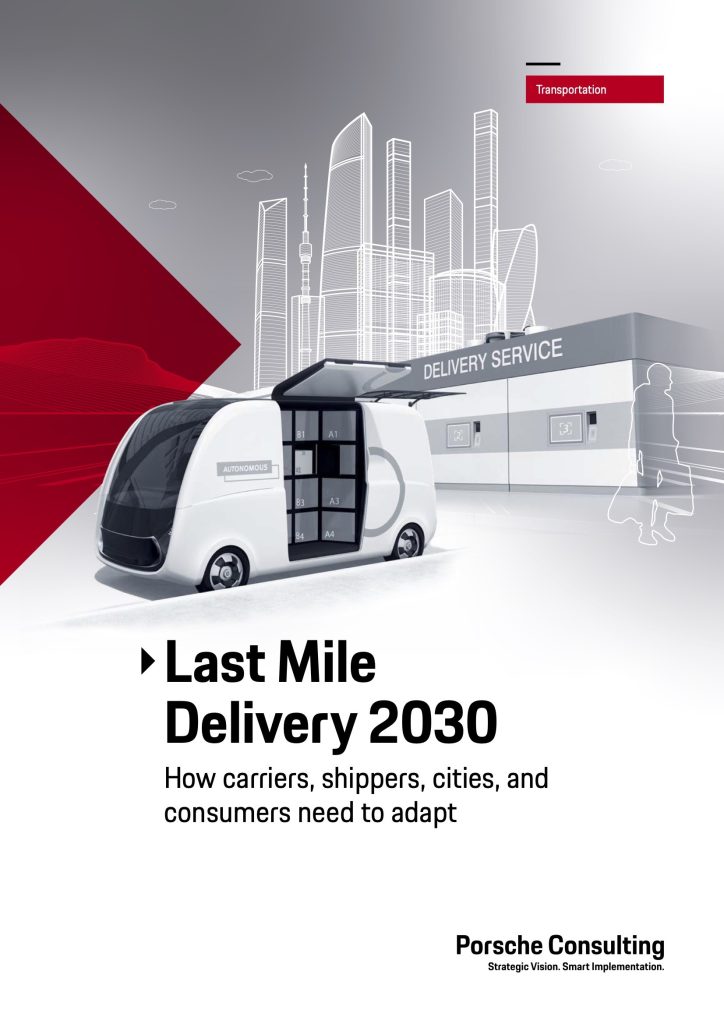Porsche Consulting’s “Last Mile Delivery 2030” strategy paper provides a detailed analysis of the changing urban logistics environment. With the surge in e-commerce, cities are implementing stricter regulations on delivery traffic, creating complex challenges for carriers, shippers, and consumers.

Key Insights:
1. Parcel Volume Growth: German parcel volumes are expected to reach 5.4 billion by 2030, a significant 35% increase from 4 billion in 2020 (Page 3).
2. Regulatory Pressure: Cities are implementing measures to reduce emissions and urban road traffic. Dr. Melanie Leonhard, Senator for Economy & Innovation in Hamburg, aims for a maximum of 45 percent of last-mile shipments to be made by light commercial vehicles by 2030 (Page 6).
3. Capacity Gap: By 2030, there could be a 30% gap between delivery capacity and projected parcel demand if alternative methods are not implemented. This translates to approximately 2.2 million undelivered parcels per day in Germany alone (Page 8).
4. Alternative Delivery Modes: Electric delivery vans, cargo bikes, and self-pick-up points are vital to addressing this gap. DHL, for example, operates 23,000 electric delivery vans and aims for 60% of deliveries to be electric by 2030 (Pages 8-10).
5. Efficiency Improvements: Optimizing parcel loading, smart packaging, and dynamic routing are essential to maximize existing resources (Page 14).
6. Innovative Solutions: Autonomous delivery shuttles, waterways, and rail transport are explored as potential solutions to increase delivery capacity (Page 15).
7. Behavioral Changes: Reducing unnecessary shipments through virtual try-on solutions and improved theft prevention can help manage parcel volumes. Nearly 1 out of 10 customers globally suffered from parcel theft in 2022 (Pages 16).
EV Battery Swap: A Game-Changer for Last Mile Delivery
The rise in parcel volumes and stricter regulations call for innovative solutions in the logistics sector. At Open Energy, we believe that EV Battery Swap technology can address many of these challenges, as highlighted in Porsche Consulting’s strategy paper.
Addressing the Capacity Gap and Sustainability Concerns
EV Battery Swap technology offers a practical solution to the capacity gap and sustainability concerns in urban logistics. By enabling rapid battery exchanges in under three minutes, vehicle downtime is minimized and operational efficiency is maximized. This approach is particularly beneficial for last-mile delivery fleets that need to maintain a high turnover rate.
Energy Arbitrage and Cost Reduction
HyperSwap allows fleet operators to charge batteries during off-peak hours when electricity is cheaper. This cost-efficiency helps maintain a lower cost per kilometer than ICE vehicles, even as they transition to more sustainable electric options. This approach also supports the electrical grid by potentially feeding energy back during peak demand, stabilizing the grid and making it easier to integrate millions of new EVs.
Autonomous Energy for Autonomous Vehicles
At the Hyundai Cradle event, which discussed Autonomous Energy combined with Autonomous Vehicles, I noticed that while concepts like Wireless Charging and battery pack robots are intriguing, they come with significant drawbacks. Wireless Charging adds cost and weight to EVs, and its efficiency drops in real-world conditions where the bottom of the EV gets dirty. Additionally, aligning the charging parts can be challenging. On the other hand, robots carrying battery packs are costly because each robot can only service a limited number of EVs, and the charging process, whether slow or fast, can degrade the battery chemistry over time.
HyperSwap: The Optimal Solution
Compared to these alternatives, EV Battery Swap is more affordable, faster, and efficient for Autonomous Vehicles. This solution aligns perfectly with the insights from Porsche Consulting’s strategy paper, addressing the need for innovative, sustainable urban logistics solutions. HyperSwap supports multiple battery pack standards, ensuring flexibility for diverse fleet compositions, and its energy storage capabilities contribute to grid stability.
Personal Takeaway
We are currently in discussions with major stakeholders in energy, EV manufacturing, governments, and fleet operators. There is a strong interest in EV Battery Swap technology across the board. In today’s on-demand world, where services like Uber, Amazon, and food delivery are booming, efficiency and clean transportation are paramount. Governments are pushing for a transition from ICE to EV, and EV Battery Swap is a logical and inevitable step in this direction.
By addressing the capacity gap, supporting grid stability, and enabling energy arbitrage, HyperSwap offers a comprehensive solution to the complex challenges outlined in the Porsche Consulting paper. As we move towards 2030, innovative, sustainable solutions like HyperSwap will play a pivotal role in transforming last-mile delivery, making it efficient, cost-effective, and environmentally friendly.